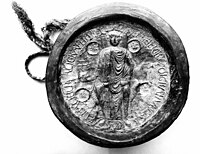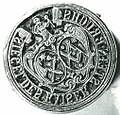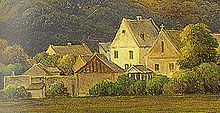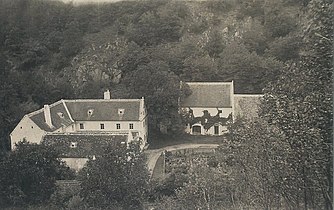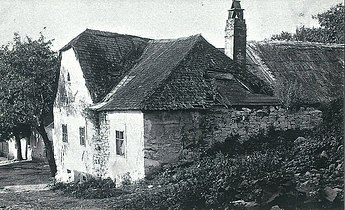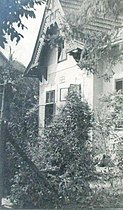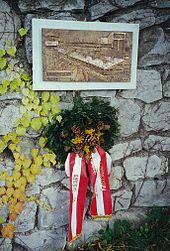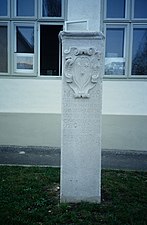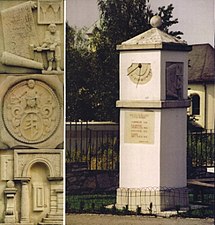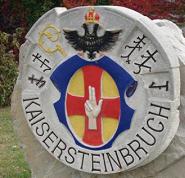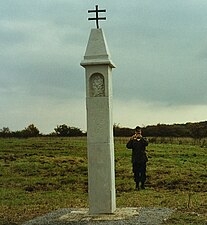Kaisersteinbruch
Kaisersteinbruch ( Hungarian: Császárkőbánya ) is a cadastral municipality in the large municipality of Bruckneudorf in the Neusiedl am See district in Burgenland .
The settlement built on the wooded, north-western slopes of the Leithagebirge was determined by the limestone that was present here since ancient times . In 1551, Emperor Charles V called Italian stonemasons and sculptors to the quarries . This created a center of high stonemasonry .
Due to the years of Turkish wars , German stonemasons took over the Kaisersteinbrucher brotherhood ; they married into the "wälschen" families. After the victory over the Turks, the architects Johann Bernhard Fischer von Erlach , his son Joseph Emanuel Fischer von Erlach and Johann Lucas von Hildebrandt as well as the master stonemason Elias Hügel determined the image of the imperial residence city with its Viennese buildings.
history
In the Blauen Bruch of the Leithagebirge , on the military training area , there are bones and teeth that allow conclusions to be drawn about the marine animals that lived here 15 million years ago . Sharks, manatees, toothed whales and baleen whales existed here . On land, palm trees, water spruces, water elms, pines and plane trees represented the flora in which monkeys, crocodiles, rhinos and tortoises moved. From the ' Einsiedler-Bruch' comes the remarkable find of a phalange ( finger bones ) of a very peculiar hoofed animal that currently has no relatives : Ancylotherium . It is kept in the Natural History Museum .
An arrowhead in a horse whirl, found in a cave of the Blauer Bruch - evidence of the oldest heavy domestic horses - documents the first traces of settlement during the Iron Age (800 to 700 BC) and is kept in the Burgenland State Museum.
Roman castrum
In 1903 the archaeologist Maximilian Groller von Mildensee found three layers of settlement on the soil of the Barren Monastery . At the bottom remains of a Roman estate (manor house, remains of buildings with heating system), past these buildings the Roman road from Carnuntum led over the Leithagebirge .
It was part of the prehistoric Amber Road that connected the Baltic and Adriatic . A Longobard cemetery was laid out near the villa in the 6th century .
Around 800, a king's court fortified with a corner tower and entrenchments was laid across the Roman foundation walls , as it served the emperors of the Carolingian era , who did not yet have a permanent residence, as a lodging and refreshment point on their travels in the empire. Later the area became the property of the Hungarian kings .
Royal gifts to the Cistercians
King Imre gave it to the Cistercians of Heiligenkreuz in 1203 . The monastery was more wealthy through foundations in Hungary than in Austria, so it considered moving to western Hungary from 1206 to 1209.
The construction of a large church on the grounds of the royal court began, but the complex remained unfinished.
The donation of 1203 was repeatedly confirmed to the Cistercians. Even King Charles Robert of the House of Anjou renewed in 1317, the rights and freedoms of establishment.
After the king's court was destroyed by the Turks in 1529, Abbot John V pledged the estate for 50 years in 1531. During this time the settlement fell into disrepair except for a church ruin. In 1937 the last Gothic window in the Barren Monastery collapsed. When inspecting the quarry in the 1990s, wall remnants with sharp edges could still be seen; these were finally removed through military exercises.
Kaisersteinbrucher Stein - Kaiserstein
The excavation of the Roman manor and tombstones, including in the Königshof Palace, testify that the Romans already broke and worked stones here . A special example is the tombstone of Titus Calidius Severus from Carnuntum in the antique collection of the KHM in Vienna.
The Kaisersteinbruch is not one quarry, but several depending on the order situation. In 1901 and 1912 technical data were collected for the Buchthal break, the forest break (Ödenkloster break), the chapel break, the house break and the Teuschl break. The following were also mentioned: Zeiler break . Pansipp break, Amelin break , Kaiserstein break, Blauer break, Black marble break, cavern break and Winkler break, as well as old Teuschl break, society break, Kowel break, Theresien break, salt lick break and Cobalt Break. A contemporary report can be read: “ The small town is completely surrounded by quarries and its houses are almost completely undermined. "
Seal of the craft
The two seals from 1801 show that the rulers were able to use the name Heiligenkreuzer Steinbruch for the craft instead of the Kaisersteinbruch .

Independent quarter store incorporates Jois, Winden and Sommerein
On 13 June 1576 the construction of Neugebaude Castle , was the new quarry at Leythaberg first mentioned.
In 1617 the brotherhood of the Kaisersteinbrucher Masters was given the status of a quarter drawer , which was assigned to the main drawer in Wiener Neustadt . To the quarter store belonged the stonemasons to Sommerein (until 1783, then to Bruck an der Leitha ) and Winden am See and Jois (until the end). The imperial privilege of the handicrafts code regulated living together. Above all, the regular meetings were a nuisance for the rulers , the Heiligenkreuz Abbey. Because these Italian masters were only subject to the Roman Emperor . They placed themselves under the protection of the supreme sovereign as a representative of God on earth, under no circumstances to any other authority.
A significant job
Also from the surrounding Hungary , the neighboring Archduchy of Lower Austria , Upper Austria , Styria , Carinthia , Bavaria , Franconia came many building professionals, from the middle of the 17th century, especially after the call of Emperor Leopold I (abbreviated) . Everyone knows that the land of Austria under the Enns has been so devastated and depopulated by the hostile Turkish invasion that there will be a great shortage of the team, especially the craftsmen, .. bricklayers, stone masons, .. a great shortage in the city of Vienna and in the countryside . Masters and journeymen, they come from wherever they want ... guilds in the country can work unhindered.
Monastery administration in Königshof Palace
From January 1, 1601 to 1912, the royal administration for the surrounding properties of the Heiligenkreuz Abbey was located in Königshof Palace; the highest authority was the administrator as the abbot's representative. Conflicts arose when the masons their craft - freedoms wanted to exercise, even if they were now subjects of the pen administration.
On June 8, 1634, judgment day in the quarry, Abbot Michael Schnabel presented the first Bannbüchel . Andre Ruffini became the first judge .
“The residents of the village of Steinbruch in Hungary refused to submit to the monastery since 1608; but in 1653 the abbot Michael knew how to lead them back to the duty of obedience through clever action “ The so-called eagle dispute over the installation of the imperial eagle in the village and on the church tower culminated in 1652 at the consecration of the church. Emperor Ferdinand III. on December 13, 1650 confirmed the craft regulations with the image of the large guild flag for the Kaisersteinbruch brotherhood.
Exemption from military billeting
The stonemasons knew how to work with Emperor Ferdinand III. To make a voice heard, who then exempted the masters Andre Ruffini , Pietro Maino Maderno , Hieronymus Bregno , Ambrosius Regondi and Domenicus Petruzzy from all public duties and services and allowed them to lead the imperial eagle at their homes. The confirmation took place on December 5, 1646.
In 1660, Emperor Leopold I granted the Kaisersteinbruch Brotherhood the Salva Guardia privilege : to be free, for yourself and your descendants, from any military billeting .
In 1661 the Hungarian court chamber complained that the Kaisersteinbrucher did not pay any duty for their stones. So on August 14, 1708, a thirtieth office was established in the village.
Turkish invasion from July 10th to September 20th, 1683
It is impossible to describe the confusion and fear these places are because of the grazing Tartars.
Many Kaisersteinbrucher left everything behind, some went to the Trautmannsdorf Fortress , while most of them hid in the Einsiedlerbruch and its vicinity. Overall, the Turkish invasion caused considerable damage to buildings and cultures, including the Heiligenkreuz administrative headquarters in Königshof. The duties and taxes that were subsequently levied by the landlord burdened the subjects; they have recently refused the thirtieth duty prescribed by the Hungarian court chamber for the export of their stones.
Hungarian Quarry Market
In the remote, difficult to access from the Hungarian side place that attracted economy of Steinmetz industry to other sectors of the economy, by this demand has been Markets awarded. Kaisersteinbruch became a transshipment point for border smuggling at the end of the 17th century , which is why a branch station for the royal thirtieth border customs was established. On market day , a count of the rulers brought 56 craftsmen and merchants to Kaisersteinbruch. These markets drew people from near and far to Kaisersteinbruch and thus became another pillar of the economic prosperity. The market town of Kaisersteinbruch existed until 1970.
The town of Kaisersteinbruch was entered for the first time on Georg Matthäus Vischer's “Little Lower Austria Map” from 1687 . ( Lower Austrian regional library , map collection A IV 78)
Masonic temple Kaisersteinbruch 1695
On the seal on the right you can see the guild symbol of the stonemasons, square and compass , which was also adopted by the first Grand Lodge of the Freemasons in England in 1723 as a symbol of their union.
The adjacent detailed view of the picture "Kaisersteinbruch" by Theodor Festorazzo, commissioned in 1847 by the rulers, the Heiligenkreuz Abbey, shows the temple.
The grave plate of the master stonemason Martin Trumler of 1705 with the Masonic symbol decorated and are thus an important clue.
The Viennese Akad. Painter Stefan Riedl depicts the establishment of the Masonic Lodge in Kaisersteinbruch. The spiritual basis was: PICTORIBUS ATQVE POETIS QVIDLIBET AVDIENDI SEMPER FVIT AEQVA POTESTAS (quote from Horace ). The German translation analogously: painters and poets rightly follow their bold inspirations , the Holy Trinity , Leonardo da Vinci , Michelangelo , Vitruvius , Plato , Palladio , Pythagoras are depicted in the upper area . The two columns delimiting the leaf , on the left the hand of the Cistercians , in the base the Masonic symbol (as on the Martin Trumler epitaph ), on the right the imperial double-headed eagle (also the Salva Guardia privilege for quarrying emperors ).
You can see the church square at Kaisersteinbruch, on the right the rectory , on the left the church building with the chapel ordered by the emperor . The artist has interwoven two levels of time, the people of the 17th century , recognizable by their clothes, and some people of the present, who walk on the church square. Some people in the past are very similar to those living today. Even if the actors from different times stand close together, there can be no contact.
- Text of the two text fields (excerpts):
- (left:) INAUGURATIO TEMPLE ... 1687 King of Hungary Joseph I from 1690 JOSEPHUS ROMANORUM REX , Grand Duke COSIMUS III. MEDICI , Cardinal FRANCISCUS ALBANI , SILVESTRO VALIERO Doge of Venice , GOTTFRIED WILHELM v. LEIBNITZ, Baron ...
- (in the middle :) a majestic symbol of the ruling Roman-German Emperor Leopold I (HRR) the Glorious ( KHM , Kunstkammer). Motto: CONSILIO ET INDUSTRIA ("Through wisdom and perseverance")
- (right :) The will to good will make victory possible - stonemason and master builder, they both build the TEMPLE
- Master stonemasons : Martin Trumler, Giovanni Battista Passerini , Sebastian Regondi , Pietro della Torre , Meister vom Stuhle and Judge Ambrosius Ferrethi ... as well as the apprentice Elias Hügel . Master masons : Georg Röckh, Mathias Juschitz, Vitus Tiefenbrunner ...
The painter Stefan Riedl has sat down to work on the left; Helmuth Furch , who saved this event from being forgotten, points to the temple.
On Saturday, September 6th, 2014 at 4 pm, the final handover will take place in the Kaisersteinbrucher "Old School" as a permanent loan to the large community of Bruckneudorf- Kaisersteinbruch.
Charles VI confirms the quarter drawer of the craft and the craft regulations
With the outbreak of the Hungarian rebellion , with the beginning of the Kuruzzenrummel in 1703, the masters and journeymen were no longer able to take part in the guild meetings in Wiener Neustadt, because strips of the Hungarian rebels prevented all travel. After 1711 the plague broke out and because of the risk of infection the connection was still interrupted. Emperor Charles VI. In 1714 approved the new construction of a quarter store for masons and stonemasons in Kaisersteinbruch, which was subordinate to the main store in Wiener Neustadt . The guild order included the order of the masters as well as the order of the foremen and journeymen .
Maria Theresa confirms the Salva Quardia privilege and the craft regulations
1743 renewed and confirmed Queen Maria Theresia - Sacracissima Regia Majestas - the Kaisersteinbrucher brotherhood that of her father Emperor Karl VI. Salva Quardia privilege granted in 1712. The document names the masters Elias Hügel, Joseph Winkler , Johann Baptist Regondi , Maximilian Trumler , Johann Paul Schilck and Franz Trumler .
On July 13th, 1747 Maria Theresa, by God's grace Roman Empress , reaffirmed the craftsmanship and freedoms to the masters in our imperial-royal quarry on Leythaberg .
Billing of French troops from July 17 to November 12, 1809
The community was very heavily burdened by the enemy troops → billeting of the French in 1810 , by lodging in their own houses and in the manorial inn, metering money, giving oats and hay for 53 horses ... that the children's children still have to pay more than 29,000 guilders . The rulers demanded that the brotherhood's Viennese capital be canceled to settle debts.
The camp set up in Bruck an der Leitha in the middle of the 19th century endeavored to keep expanding. A huge military training area with all the necessary equipment for training a modern, powerful army was to be connected. The Austro-Hungarian military therefore gradually set about buying up all of the lands that could be considered. Königshofer Stiftsgut was also considered for a long time and approached the monastery with a request for the transfer of 60 yokes.
In the Hungarian parliament , a motion had been introduced to acquire the area that King Emmerich had given the Heiligenkreuz monks more than 700 years ago, which would have amounted to de facto expropriation.
Personalities
- Michael Schnabel , abbot of Heiligenkreuz Abbey 1637–1658
- Clemens Schäffer , abbot of Heiligenkreuz Abbey 1658–1693
- Marian Schirmer , abbot of Heiligenkreuz Abbey 1693–1705
- Gerhard Weixelberger , abbot of the Heiligenkreuz Abbey 1705–1728
- Maria Elisabetha Hügelin , née Ferrethin, widowed Trumlerin , married Hügelin, † 1728
- Elias Hügel , Viennese court stone mason, judge from 1722–1735 and 1749–1751, church builder, creator of baroque stone altars
- Robert Leeb , abbot of Heiligenkreuz Abbey from 1728–1755
- Joseph Winkler , judge from 1735–1747, founder of a stonemason family in Kaisersteinbruch
- Johann Michael Strickner , judge from 1752–1765, from an Eggenburg stonemason family
- Johann Gehmacher , Salzburg, judge from 1766–1777, founder of a family of stonemasons in Kaisersteinbruch
- Gregor Nagl , master weaver, was the first “non-stonemason” to be elected judge from 1777–1793
- Peregrin Teuschl , master stonemason, judge from 1852–1859, Viennese master stonemason
- Gregor Pöck , abbot of Heiligenkreuz Abbey from 1902–1945
- Ferdinand Krukenfellner , master stonemason, judge from 1894–1895 and 1904–1912
- Ferdinand Amelin , master stonemason, judge from 1913–1923
- Josef Wolf , Mayor, author of a local history
- Friedrich sacrificial cow , master stonemason († 1993), Friedrich sacrificial cow symposium 1993
- Josef Franzl , parish rector of Kaisersteinbruch 1939–1945
- Alexandru Ciutureanu , sculptor from Bucharest, worked as an artist in Kaisersteinbruch for over a decade
- Ferenc Gyurcsek , sculptor from Budapest, worked as an artist in Kaisersteinbruch for over a decade
- Hans Rochelt , cultural editor of Radio Burgenland, Radio Pannonia, etc.
- Klara Köttner-Benigni , employee of Radio Burgenland, reporting on the museum and cultural association
- Helmuth Furch , teacher, cultural worker and author
Sale of Kaisersteinbruch to the military
The sales negotiations were concluded on October 31, 1912 in the presence of Abbot Gregor Pöck; the area of the quarries was sold to the kuk war ministry . These negotiations took place without the knowledge and participation of the Kaisersteinbruch residents.
“When the final contract is drawn up in Császárkőbánya, the War Ministry will be headed by Ernst Berger, head of the section , and then by Dögl, Chief Military Officer, 2nd class. Also the legal representative of the military ars royal. Council Pajor has to be present. The Heiligenkreuz Abbey will be represented by its abbot, His Grace Gregor Pöck, the "Patria" ( Helvetia Patria Versicherung Basel ) by the officials authorized to produce, bank director Spitzmüller and Professor Landesberger. "
The Heiligenkreuz Abbey did not have full freedom of action, as the state can assert claims on militarily relevant real estate. For this the monastery received 3,500,000 crowns and subsequently acquired extensive forest areas around Wasserberg in Styria. The demands of the Bruck camp for more training ground were met.
Picture gallery of the missing Kaisersteinbruch from the Burgenland History Blog by Dr. Herbert Brettl
World War I - POW camp
The military history of Kaisersteinbruch began in the First World War . A prisoner of war camp was built on one side of the street at the lower end of the village . The Viennese construction company Janisch & Schnell built large wooden barracks that were used to accommodate 2,000 to 3,000 prisoners of war.
The prisoners of war were used to produce gravel in the Blauer Bruch ; They also built a new road between Kaisersteinbruch and Winden am See ("Russenstraße"), a cable car from the Blauer Bruch to the middle of the camp and a field railway track from the Wilfleinsdorf station to the camp.
When the Danube Monarchy fell apart, Kaisersteinbruch initially remained Hungarian. The state border ran directly behind the church in the direction of Leitha . Wilfleinsdorf and Sommerein were Austrian.
Population of the parish 1920
One year before Burgenland was annexed to Austria , 448 German , 310 Magyar , 5 Croat and 11 other residents lived here and 668 belonged to the Roman Catholic religion, 23 to the Protestant AB , 50 to the Protestant HB and 7 to the Israelite religion .
1934 - Detention camp
In January 1934, part of the military camp was set up as a detention camp for National Socialists and on February 12, shop stewards of the social democratic and communist parties and the Austrian Federation of Trade Unions arrested in Burgenland were brought here.
Second World War - Resettlement - POW camp STALAG XVII A
In 1938 the Kaisersteinbruch stopping camp (Camp I) was taken over by the German Wehrmacht together with the barracks and expanded and expanded in the following period. The local population had to due to space requirements of the armed forces to leave their homes and was relocated to build the POW camp Stalag XVII A . Kaisersteinbruch was the first prisoner-of-war camp in the Ostmark area , and at the same time one of the first camps in the entire Reich. The maximum number was in February 1941 with 73,583 soldiers, 970 officers and 220 civilians.
Due to the huge number of dead prisoners of war from the winter of 1941/42, a camp cemetery with mass graves was built a few hundred meters from the camp . In the State Treaty of May 15, 1955, 9,584 Soviet soldiers are mentioned who had died.
Cinema in the guest house
In the neighboring town of Breitenbrunn, people remember that there were hardly any entertainment options after the war. Only in Kaisersteinbruch were films played in the inn and so you walked across Russenstrasse and back again after the performance. “ Mask in Blue ” with Marika Röck was played once.
The "new" Kaisersteinbruch
On March 7, 1951, the Burgenland state parliament in the Soviet-occupied Burgenland again decided on the municipality of Kaisersteinbruch. Josef Wolf , Mayor, writes in this context " it was very strange that the municipal administration had not been invited to this important state parliament meeting ". It was even more disconcerting that after months of waiting there was no legal gazette to read about this state parliament resolution and the municipality was not informed by the Burgenland state government. It was not until 1952 that the law passed was published in the State Law Gazette.
A great service to the community Kaisersteinbruch had the land register - Judge Spath acquired in that it the application of the Gauleiter of Lower Danube , left lying for years incorporate Kaisersteinbruch land register for the "German Reich", the property of the dissolved municipality and the execution delaying so long until the war was over and things settled itself. With this courageous act, the municipality of Kaisersteinbruch has remained the absolute owner of its real estate. So the community could be rebuilt despite great resistance.
As early as 1956/57 the barracks of the camp were used for many thousands of refugees from the Hungarian uprising . The place itself was largely destroyed.
Uchatius barracks
Due to the separation from the Bruck military training area in 1958, the expansion to the independent Kaisersteinbruch site took place. On May 16, 1961, the existing camp I was renamed "Leitha- Kaserne " . After the necessary extensions and modernizations, the barracks received its new name "Uchatius-Kaserne" on November 25, 1967, after the weapons technician Field Marshal Lieutenant Freiherr von Uchatius .
Location of some films
- The good soldier Schwejk : some passages were filmed on site in 1960, including with Heinz Rühmann under the direction of Axel von Ambesser .
- Love hangs on the gallows : also in 1960 some scenes werefilmedwith Annie Rosar under the direction of Edwin Zbonek . Some of the local population served as extras.
- Escape of the white stallions , in 1963 nature photos were taken with the Lipizzaners in the quarry area, with Robert Taylor , Lilli Palmer , Curd Jürgens .
- History comes to life , February 23, 1991 on ORF 2, TV film by Hans Rochelt .
Kaisersteinbruch military dog center
In 1964 a military dog squadron was founded in Kaisersteinbruch.
First tourism advertisement
Together, Breitenbrunn , Winden and Kaisersteinbruch brought out a color brochure for the Neusiedlersee recreation area in Burgenland / Austria. At that time one could still advertise with the impressive "Blue Break", which belonged to the local recreation area Kaisersteinbruch. Years later the whole area was incorporated into the military training area.
Amalgamation of municipalities with Winden, Sommerein or Bruckneudorf
Kaisersteinbruch has been a cadastral community since 1971, as well as part of the large community of Bruckneudorf , Neusiedl am See district , Burgenland . Before that it was an independent municipality, even a large municipality through the district of Königshof. The hotter area is 14 square kilometers and is inhabited by only 280 inhabitants (as of December 31, 2005); this results in a population density of 20 people per square kilometer. That corresponds to the value of the Republic of Equatorial Guinea . The explanation is that parts of this area are separated by the military training area with prohibition signs “Danger to life”.
Barrack camp in Kaisersteinbruch
The Salzburger Nachrichten of March 3, 1990 reported: The 200-inhabitant municipality of Kaisersteinbruch in Burgenland continues to fight against the relocation of 800 male Romanian refugee recruits to the barracks there, as ordered by Interior Minister Franz Löschnak .
On March 15, 1990, Romanians were required to have a visa , Kaisersteinbruch became a symbol in the media for narrowness, foreigners' lockout ... Many expect from this small place what nobody else is willing to give.
Attractions
Plague Cross 1648 A. Regondi
This association had set itself the task of reviving the destroyed local culture since 1990.
- Parish church Kaisersteinbruch
- Altars of the Kaisersteinbruch Church
- Steinmetzmuseum Kaisersteinbruch
- Kuruzzenkreuz, 1646, donor Paul Cleritz , a plague cross .
- Plague cross, 1648, donor Ambrosius Regondi , with coat of arms.
- Former Rectory, 1649 residence for the first catholic. Local pastor
- Baroque cemetery portal, Ambrosius Ferrethi , composed of different parts in the second half of the 17th century, Mary, above the Trinity , to the side Sebastian and Rochus.
- Elias Hill Column of Honor, 1740, dedicated to the great master by the stonemasons' brotherhood.
- Hungarian Symposium Stone, Ferenc Gyurcsek
- Austrian symposium stone, Christoph E. Exler
- Romanian Symposium Stone, Alexandru Ciutureanu
- Sundial pillar, 1992, led by Friedrich sacrificial cow , sundial stone from 1590, reliefs Ciutureanu.
- New Kaisersteinbrucher Florian , sculptor Ferenc Gyurcsek, 1992, stands in the tower of the fire station.
- Ortstein by sculptor Alexandru Ciutureanu , version by Ava Pelnöcker, 1997.
- Europabrunnen, built in 1998 on the church square, along the stone wall of the former parish garden. In the 10 years, sculptors represented their country with stone reliefs . In front of it the rose garden "Stone and Rose".
- Exit to the vaulted cellar made of Kaiserstein steps of the Albertina in the Hofburg , the castle administration handed over the steps of the Sphinx staircase to the museum after the conversion to the marble staircase. A masterpiece by Georg Zsalacz.
- Kaisersteinbruch and the surrounding area around 1883 (recording sheets of the state survey )
literature
- Felix Czeike : Historical Lexicon Vienna . Volumes 3-5, 1994-1996. Texts on Elias Högl , Fam. Högl , Kaisersteinbruch, J. Lorentisch , Pietro Maino Maderno , Friedrich Opferkuh , GB Passerini , A. Payos , A. Pery , S. Sasslaber , M. Trumler .
- Herbert Haupt : The court and court-exempt craft in baroque Vienna 1620–1770 , assigns Kaisersteinbruch to the imperial court stone masons Elias Hügel, Pietro Maino Maderno, Giorgio Regondi , Johann Carl Trumler and Johann Baptist Regondi for this time .
- Helmuth Furch : Historical Lexicon Kaisersteinbruch . 2 volumes. Museum and cultural association, Kaisersteinbruch 2002–2004. ISBN 978-3-9504555-8-8 .
- Helmuth Furch: Messages from the museum u. Kulturvereines Kaisersteinbruch, 1990–2000 . 59 volumes. ( permalink.obvsg.at ), ISBN 978-3-9504555-3-3 .
- Hans Hahnenkamp : Burgenland industry . 1st chapter. 1986.
- Hermann Häusler, with contributions by Harald Figdor, Christa Hammerl , Franz Kohlbeck, Wolfgang Lenhardt and others. Ralf Schuster: Geological map of the Republic of Austria 1: 50 000 - Explanations of the geological map 78 RUST , which contains detailed discussion of the Kaisersteinbrucher quarries, Federal Geological Institute , Vienna 2010. ISBN 978-3-85316-055-8 .
- Gunnar Strunz : Burgenland, nature and culture between Lake Neusiedl and the Alps, Kaisersteinbruch , p. 112 f. Trescher Verlag , Berlin, 1st edition 2012, ISBN 978-3-89794-221-9 .
- Brigitte Krizsanits, Manfred Horvath : The Leithagebirge, border and connection. Kaisersteinbruch, center of stonemasonry , conversation with Helmuth Furch in March 2012, pp. 75–79. Art on stone , p. 207 f. Publishing House Library of the Province 2012. ISBN 978-3-99028-172-7 .
- Austrian Art Topography , Volume LIX, The Art Monuments of the Political District of Neusiedl am See . Published by the Federal Monuments Office, editorial management Andreas Lehne . Verlag Berger , Horn, 2012, pp. 120–150. ISBN 978-3-85028-554-4 .
- In the cited literature (pp. 813–814), the writings of Helmuth Furch from 1981 to 2007 are cited in 13 references. But also authors who have written in the "Mitteilungen des Museums- und Kulturverein Kaisersteinbruch ", such as the art historian Anna Maria Altmann, the mayor Josef Wolf , the archaeologist Heinrich Zabehlicky, can be found here.
- Werner Telesko (ed.), The Hofburg 1835-1918, The expansion of the residence of the Vormarz to the end of " Imperial Forum ". Year of publication 2012, ISBN 978-3-7001-7231-4 , Austrian Academy of Sciences . Some examples of the Kaisersteinbruch research on completeness :
“The court museums”, “The building process, problems with the stone material” p. 200–203: Kunsthistorisches Museum , for the facade of the upper floors sand-lime bricks from Bruck an der Leitha , Winden am See , Kroisbach , the Breitenbrunner sand-lime stone and the Kaisersteinbrucher limestone . The stairs, balustrades , candelabra at the access ramp from Kaisersteinbruch, Oslip and Wöllersdorf .
- Natural history museum , master stonemason Ferdinand Krukenfellner delivered hanging panels for the main cornice from the "Ödenkloster Steinbruch", from the large "Zeindlerbruch", in 1876. The very hard stone from the "broken house" of the Amelin family of stonemasons was used for smooth pillars .
In the chapter “The completion of the Michaeler tract (1888-1893)” pp. 242–255: Completed by Ferdinand Kirschner using Fischer's plans . The base consists of 20 cm thick panels from Kaiserstein. The balcony slabs for the large passage to Michaelerplatz came from Kaisersteinbruch, no other quarry could deliver such large workpieces.
- "Zeindler stone", a hard imperial stone, was used for the pillars of the new festival staircase.
- The steps of the treasure chamber stairs , new name " Gottfried von Eine " stairs from Kaiserstein. In: Alois Kieslinger, “Die Steine der Wiener Ringstrasse”, 1972. Helmuth Furch, Mitteilungen des Museums- und Kulturverein Kaisersteinbruch, No. 59, December 2000. p. 22, Stone exploration with Andreas Rohatsch , Technical University of Engineering Geology, Michaelertrakt.
In the chapter “The Staircase in the Segment”, pp. 336–341: A decision was made for the staircase in the “Segment” - up to the mezzanine made of Lasa marble , the rest of the Kaiserstein (Hofbau-Comite file no. 25832). During these years marble stones had pushed the Kaiserstein into side rooms, as basement and floor stairs.
- Herbert Karner (Ed.), The Vienna Hofburg 1521–1705, building history, function and establishment as an imperial residence . Year of publication: 2014, ISBN 978-3-7001-7657-2 .
In the chapter "The old castle (Schweizerhof) 1521-1619" you can read: The late Gothic profiled natural stone walls in situ .., note 20 (p. 82): This was made after the friendly verbal information of Andreas Rohatsch (TU Engineering geology) is most likely made of Kaiserstein.
- The Steinmetzmuseum Kaisersteinbruch had carried out stone explorations in the old castle with Andreas Rohatsch and published them all in the communications of the Kaisersteinbruch Museum and Culture Association .
- P. 111 The monumental wall fountain with a double eagle relief and the year 1552 is made of imperial stone.
- The construction clerk Lucas Ehrlinger had assigned the "Kayser Stainbruch" near Mannersdorf . This also happens now in the index of this book, of course the masters Ambrosius Ferrethi and Camillo Rezi are Kaisersteinbrucher master masons and subjects of the Heiligenkreuz Abbey . P. 382 (note 2216) and p. 293: Demands by Camillo Rezi and Ambrosius Ferrethi, two Italian stonemasons from Mannersdorf.
In the chapter "Building materials" (pp. 458–459) you can read: The bricks were .. extracted from quarries that .. delivered architectural parts that were worked on sight. For the 17th century, mainly Kaisersteinbruch. Note 127: This can be assumed, but there is only clear evidence for the construction of the Leopoldine wing. FHKA, NÖHA W 61 / A 2. fol. 949r-950r (1665).
- Mario Schwarz (Ed.), The Vienna Hofburg in the Middle Ages. From the fort to the beginnings of the imperial residence Year of publication: 2015, ISBN 978-3-7001-7656-5 . Andreas Rohatsch, The building stones of the 13th century of the Michaelerkirche in Vienna . Austrian Academy of Sciences .
- In the local directory reference to Kaisersteinbruch, pp. 126, 127, 130-133, research on Kaiserstein , Ödenkloster Steinbruch . Note 584 Furch 1981, Rohatsch 2007.
- Hellmut Lorenz , Anna Mader-Kratky (ed.): The Vienna Hofburg 1705-1835, the imperial residence from baroque to classicism . Verlag der Österreichische Akademie der Wissenschaften, published in Vienna 2016, ISBN 978-3-7001-7843-9 .
In the chapters: “First Mariatheresian conversion of the imperial apartments” (in the Leopoldine wing) and “The balcony to the suburbs (May 6, 1752)” (p. 275) is - from Kaisersteinbruch's point of view - a highlight of these works. This (so to speak "sensational") document of the court building office in the house and court and state archive with the text:
- SPECIFICATION their rogues to the New Altona in the Kayl. Castle, after the formed crack.
- 12 TRAGSTEIN from KAYßER STEINBRUCH including ornaments ... This was published in the communications of the Museum and Culture Association No. 38, August 1995, pp. 24-26.
- The Steinmetzmuseum Kaisersteinbruch had carried out stone explorations with Andreas Rohatsch in the large staircases of the Hofburg and published them all in the communications of the Kaisersteinbruch Museum and Cultural Association . In addition this entry:
- E. Mitterhuber and Ursula Stevens - 2016
- Research on Ticino artists in Europe 13. – 19. Century , for the place of work Kaisersteinbruch, the following literature was used: Helmuth Furch, Historisches Lexikon Kaisersteinbruch , 2 volumes, 2004, the links given point to the Wikipedia articles Kaisersteinbruch, The Kaisersteinbrucher Brotherhood, The craft of stone masons and masons in Kaisersteinbruch, as well as many masters , e.g. B. Bregno, Ruffini, Maderno, Crivelli, Ferrethi, Passerini, Regondi ....
- This research will - finally - integrate the Kaisersteinbrucher Brotherhood in Europe and add important data.
- http://www.tessinerkuenstler-ineuropa.ch/deu/kaisersteinbruch-deu.html
Web links
- August Hanisch, Heinrich Schmid: Austria's quarries. Directory of the quarries that deliver cuboids, steps, paving stones, grindstones and millstones or roof slabs. Graeser, Vienna 1901. (Online at ALO ).
- https://www.geologie.ac.at/fileadmin/user_upload/dokumente/pdf/poster/poster_2011_archaeometrie_kongress_heinrich_et_al_2.pdf Leithagebirge
- Museum and culture association Kaisersteinbruch
- Helmuth Furch 2002, Historisches Lexikon Kaisersteinbruch Volume 1 , 2004, Volume 2 with some of the author's life data
- Helmuth Furch 1992/2015, Elias Huegel - Hofsteinmetz with pictures and text on the " Freemason Lodge in Kaisersteinbruch " and the picture " Apotheosis of Elias Hügel ", Elias Hügel 2005, the major order Karlskirche determined his life
- Helmuth Furch 1995, Kaisersteinbrucher Church Festschrift
- Helmuth Furch, Schönbrunn Palace, and the "Kaiserstein"
- Helmuth Furch 1995, Graefl. Harrachsche Archives and the Kaiser Quarry
- Hubert Speckner 1995, Stalag 17A Kaisersteinbruch
- Announcements of the Museum and Culture Association Kaisersteinbruch May 2007
- Kaisersteinbruch in "Ticino Artists in Europe" http://www.tessinerkuenstler-ineuropa.ch/deu/kaisersteinbruch-deu.html
Individual evidence
- ↑ Hans Schwengersbauer: Kaisersteinbruch, former Amelin quarry "Blauer Bruch". - Documents for the excursions of the 7th Annual Meeting of the Austrian Palaeontological Society, 12. – 14. October 2001, Mannersdorf am Leithagebirge.
- ↑ 2nd International Pentecost Meeting of Microscopists. MGW 2004, Helmut Reichenauer.
- ↑ Geological Survey : ? Hermit break. '
- ↑ Burgenland Topography I., p. 232.
- ↑ Federal Geological Institute: Blauer Bruch.
- ↑ AF Tauber: The geological and palaeontological results of the excavations in the cave in the Blauer Bruch near Kaisersteinbruch . In BHbl., Year 11, 1949.
- ↑ Horst Adler : Longobard fibula from Kaisersteinbruch, Burgenland . Archaelogia Austriaca, Volume 65, 1981. Right-hand S-brooch made of gold-plated silver . The relatively wide middle section is bordered by two webs and bears a serpentine cut that imitates a meander . At each end there is a circular cell with red glass inlays , depicting the eyes of a bird of prey , one of which, however, has failed. From each of these cells a two-pronged, curved beak leads back to the central part. On the back there is the co-cast spiral and needle holder , but no remainder of the needle construction itself, which was originally made of iron .
- ↑ Manfred Alois Niegl: The archaeological research of the Roman times in Austria . Austrian Academy of Sciences, Vienna 1980, p. 158. ISBN 3-7001-0336-0 .
- ↑ Hermann Watzl : The plan to relocate the Cisterce Heiligenkreuz from the Vienna Woods to western Hungary in the years 1206 to 1209. in: Yearbook for regional studies of Lower Austria. New series 34, 1958–1960, pp. 106–119 ( PDF on ZOBODAT ). Reprinted in: Hermann Watzl: "... in loco, qui nunc ad sanctam crucem vocatur ..." Sources and treatises on the history of the Heiligenkreuz Abbey. Heiligenkreuz 1987, pp. 431-444.
- ↑ Harald Prickler : Cistercians as landlords in the Burgenland-West Hungarian area . In: 800 years of the Cistercians in the Pannonian region . 1996.
- ↑ Erich Draganits, Andreas Rohatsch, Hannes Herdits: Roman stones along the Burgenland Amber Road, No. 21 in Kaisersteinbruch - Königshof Castle.
- ^ Ödes Kloster Steinbruch Waldbruch. .
- ↑ Broken Chapel. .
- ↑ Hausbruch. .
- ↑ Zeilerberg.
- ^ Cavern breach. .
- ↑ Old Teuschl break. .
- ^ Break in society. .
- ↑ A. Hanisch, H. Schmid: Austria's stone quarries. Directory of the quarries that deliver cuboids, steps, paving stones, grindstones and millstones or roof slabs . Vienna 1901.
- ↑ A. Hanisch: Examination results with natural building blocks . Vienna 1912.
- ↑ Andreas Rohatsch, Kaisersteinbruch: Leithakalk in the best quality In: Thomas Hofmann (Ed.), Vienna-Lower Austria-Burgenland, walks in the history of the earth. Federal Geological Institute . Vienna 2007, ISBN 978-3-89937-074-4 , p. 172 f.
- ↑ Hofkammerarchiv Vienna, rulership files 1576: First mention: Quarry at Leithaberg
- ↑ City Archives Wiener Neustadt : Steinmetzakten .
- ↑ Helmuth Furch: The quarter drawer of the stonemasonry and bricklaying trade in the imperial quarry in its relation to the Viennese main drawer - 17./18. C. In: IV. International Craft History Symposium Veszprém , 9.-11. November 1994 . Edited by the Hungarian Academy of Sciences , Budapest / Veszprém 1995, pp. 99–102.
- ↑ Franz Probst in the BF 16, post September 1987 (excerpts): .. The quarries of Kaisersteinbruch attracted artists from Italy, which founded here something like a separate colony, while not the size of a Bauhütte reached her in resembled the structures . It influenced the building process of the room significantly. One of these newcomers was the Lombard sculptor Stefano Maderno . He created his works primarily for Rome, also stopped in Kaisersteinbruch on his travels and worked here temporarily with his brother Carlo Maderno and other compatriots ...
- ^ Archive Mosonmagyaróvár : Codex Austriacus “12. February 1684, Leopoldus "
- ↑ P. Malachias Koll : The Heiligenkreuz Abbey. Vienna, 1834. p. 118.
- ↑ Ed. Burgenland Provincial Government : General Landestopographie des Burgenlandes, The administrative district Neusiedl am See , 1st volume, The shares of the Stiftsherrschaft Heiligenkreuz , p. 77. Eisenstadt 1954.
- ^ Helmuth Furch: Historisches Lexikon Kaisersteinbruch, Wimmer Johann jun. Vol. 2, p. 845. Kaisersteinbruch 2004.
- ^ Archive Stift Heiligenkreuz, With these words begins a letter from the pastor of Mönchhof P. Augustin Liechtenfurth of July 2nd, 1683 to the administrator in the Königshof P. Franz Rädler
- ^ E. Mitterhuber Ursula Stevens, Ticino artist in Europe 13. – 19. Century Imperial Quarry 2016
- ↑ Helmuth Furch, " The Brotherhood of the Kaisersteinbrucher Steinmetzmeister, 1650-1730 " p. 5, 2007. ISBN 978-3-9504555-4-0 .
- ↑ Hans Kietaibl: The brotherhood of bricklayers and stonemasons in Kaisersteinbruch 1714 . In: Helmuth Furch: Elias Hügel, Hofsteinmetzmeister ISBN 978-3-9504555-2-6 .
- ^ "Billing of French troops from July 17th to November 12th 1809 in Kaisersteinbruch" . In Mitteilungen No. 53, March 1999, pp. 21-33.
- ^ Vienna War Archives 1912 Sale of the Königshof to the military ararian.
- ↑ Alkuin Schachenmayr : Wasserberg was owned 100 years ago in Heiligenkreuz , in: Sancta Crux 74 (2013), pp. 156–163.
- ↑ General topography of Burgenland, 1954. p. 235.
- ↑ Commandant of the military training area Bruck ad Leitha, letter dated July 24, 1939, it is suggested to them to get an apartment, since the place Kaisersteinbruch has to be evacuated on October 1st of that year.
- ↑ Hubert Speckner
- ↑ Camp cemetery of Stalag XVIIA - Marterl.at/ [1]
- ↑ Fritz Damerius: Breitenbrunn, history and stories , author publisher Gerbgruben. The Second World War p. 54 f. ISBN 3-902119-03-9 .
- ^ Bruno Böröcz private collection: Kaisersteinbruch parish rebuilt. Newspaper reports from 1950 . In Mitteilungen No. 28, July 1993, pp. 19-23.
- ↑ Josef Wolf: The history of the community Kaisersteinbruch . In: Mitteilungen and Ein Kaisersteinbrucher Life: Josef Wolf, 1892–1966, especially 1938–1955 . Reprint 2005.
- ^ Gregor Ball: Heinz Rühmann: His films - His life. Heyne, 1981, ISBN 3-453-86024-1 .
- ↑ Helmuth Furch: From Heiligenkreuzer Steinbruch to Kaisersteinbruch , 1981, p. 108f. ISBN 978-3-9504555-0-2 with two photos.
- ↑ For a screening on March 25, 1995, Mr. Walter Fritz , head of the Austrian Film Archive, provided the film rolls; the director Edwin Zbonek and the cameraman Walter Partsch were present . In “ Communications of the Museum and Culture Association ” No. 37, May 1995, p. 45.
- ^ Helmuth Furch: Historisches Lexikon… p. 486.
- ↑ Historisches Lexikon Kaisersteinbruch , 2004. Index: March 3, 1990 Salzburger Nachrichten.
- ↑ So-called Kuruzzenkreuz, but probably a plague cross , with a plan sketch by Master Friedrich Opferkuh. In Mitteilungen No. 23, December 1992, p. 19.
Coordinates: 47 ° 59 ′ 17.6 ″ N , 16 ° 42 ′ 6.5 ″ E






